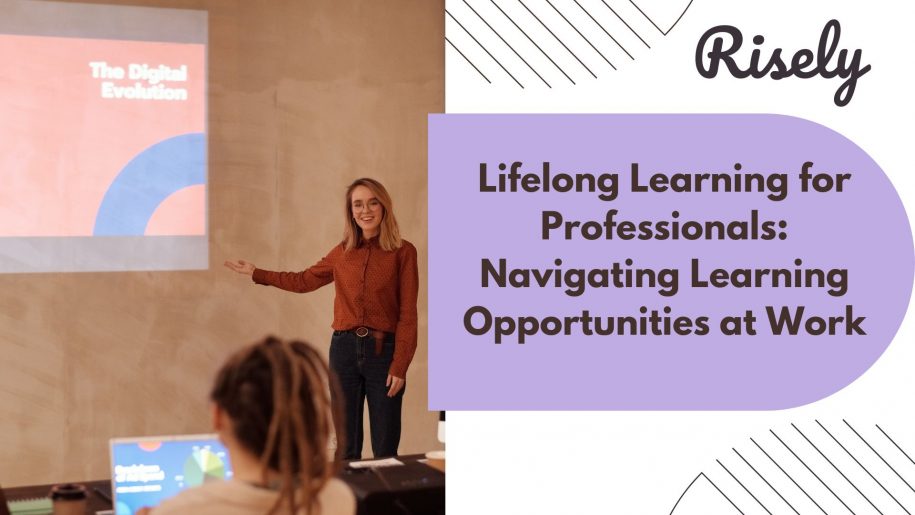Lifelong Learning for Professionals: Navigating Learning Opportunities at Work
In today’s ever-evolving business, the adage “knowledge is power” has never held more truth. As organizations strive to remain competitive and agile, the key to success lies in unlocking the potential of their most valuable asset – their employees. We will explore the boundless world of learning opportunities at work. From Fortune 500 companies to nimble startups, organizations worldwide are discovering the profound impact of providing employees with continuous learning opportunities at work. In this digital age, where information is just a click away, the value of cultivating a culture of learning at work cannot be overstated. We delve into the myriad benefits of offering diverse learning avenues tailored to suit individuals’ unique needs and aspirations across teams and hierarchies.What is the role of learning and development managers?
The role of L&D managers is to design, implement, and oversee learning and training programs within a team. They are crucial in fostering employee growth, skill development, and knowledge enhancement to support overall success. Here are the essential responsibilities and functions of learning and development managers:- Training needs assessment: They identify the training needs of employees and the organization through various methods, such as surveys, performance evaluations, and consultation with department heads.
- Training program design: Learning and development managers design training programs and initiatives to address the identified needs. They create content, select training methods, and develop learning materials tailored to employee roles and skill levels.
- Training delivery: They deliver training sessions or facilitate workshops either in person or through digital platforms. This may involve conducting training themselves or coordinating with internal or external trainers.
- Professional development: They encourage and support employees’ professional growth by providing access to workshops, seminars, conferences, and online courses that align with their career aspirations.
- Learning culture advocacy: They foster a culture of continuous learning within the organization, encouraging employees to embrace personal development and knowledge-sharing.
Why is it important to create learning opportunities at work?
Creating learning opportunities at work is crucial for several reasons:- Employee development and growth: Learning opportunities enable employees to acquire new skills and knowledge, fostering personal and professional development. This growth empowers them to take on new organizational challenges and responsibilities.
- Increased employee engagement: Providing learning opportunities shows that the organization invests in its employees’ growth and success. This, in turn, boosts employee engagement and job satisfaction, leading to higher productivity and lower turnover rates.
- Enhanced performance and productivity: As employees acquire new skills and knowledge, their performance and productivity will likely improve. They become more proficient at their tasks, leading to better outcomes for the organization.
- Talent retention: Organizations prioritizing learning opportunities are more likely to retain top talent. Employees are more likely to stay with an employer that invests in their growth and provides a pathway for advancement.
- Succession planning: Developing talent from within the organization ensures a pipeline of skilled employees ready to take on leadership roles when needed. This strategic approach to talent development enhances the organization’s long-term stability and success.
- Effective knowledge transfer: Learning opportunities facilitate knowledge sharing and transfer within the organization. Experienced employees can pass on their expertise to newer team members, preserving institutional knowledge.
Other Interesting Reads
How do L&D managers find learning opportunities at work?
Learning and Development (L&D) managers can find learning opportunities at work through various methods and resources. Here are some effective strategies they can employ:- Industry research: Stay updated on industry trends, best practices, and emerging technologies. Research professional development opportunities, certifications, and workshops that align with the organization’s goals.
- External training providers: Partner with reputable external training providers, consultants, or subject matter experts who offer specialized training in relevant areas. They can bring fresh perspectives and expertise to the organization.
- Online learning platforms: Utilize online learning platforms that offer a wide range of courses and resources. These platforms allow employees to access learning materials at their own pace.
- In-house experts: Identify internal subject matter experts within the organization who can lead workshops or training sessions on specific topics. Encourage knowledge sharing among employees.
- Cross-departmental collaboration: Collaborate with different departments to identify learning needs that align with their goals and projects. This approach ensures that learning opportunities are relevant and impactful.
- Conferences and seminars: Attend industry conferences, seminars, and workshops to stay informed about the latest developments and networking opportunities. These events often offer valuable insights and knowledge sharing.
How do L&D managers create learning opportunities and make learning a part of everyday work?
L&D managers play a critical role in creating learning opportunities at work and integrating learning into employees’ everyday work experiences.- Learning culture promotion: L&D managers work to foster a learning culture within the organization. They communicate the value of continuous learning and professional development to employees at all levels. Encouraging a growth mindset and a passion for learning helps employees see learning as an integral part of their job.
- Personalized learning paths: Rather than a one-size-fits-all approach, L&D managers create personalized learning paths for employees based on their roles, aspirations, and skill levels. This ensures that the learning opportunities are relevant and tailored to individual needs.
- Blended learning approaches: L&D managers use a combination of learning methods to accommodate various learning styles. Blended learning approaches, such as workshops, e-learning modules, on-the-job training, and coaching, allow employees to learn through diverse channels.
- Learning management system implementation: Implementing an LMS streamlines learning opportunities. L&D managers use the LMS to centralize course catalogs, track employee progress, and deliver online training materials. The LMS facilitates self-paced learning and provides easy access to learning resources.
- Microlearning and bite-sized content: Microlearning is gaining popularity as it delivers short, focused bursts of content that employees can consume in small increments. L&D managers use microlearning to offer quick, digestible lessons that fit into employees’ busy work schedules.
- Integration with performance management: To make learning a part of everyday work, L&D managers integrate learning and development goals into the performance management process. They link learning outcomes to performance reviews and employee development plans.
- Learning communities and employee forums: Establishing learning communities and employee forums allows individuals with shared interests to collaborate, exchange knowledge, and support continuous learning. These forums foster a sense of community and encourage peer-to-peer learning.
- Recognition and rewards: Recognizing and rewarding employees for their learning achievements incentivize continuous learning. L&D managers work with HR and leadership to create recognition programs celebrating employees’ commitment to professional growth.
Conclusion
As we reach the culmination of our blog on learning opportunities at work, one truth stands unwavering – the impact of continuous learning on individuals and organizations is nothing short of transformative. Throughout this journey, we have unraveled the immense power of fostering a workplace culture of growth and curiosity. Learning opportunities at work are not merely a checkbox to tick or a formality to fulfill. They are the building blocks of a thriving organization, where employees are empowered to reach their full potential. From honing technical skills to nurturing leadership qualities, the quest for knowledge catalyzes professional excellence.Unlock the full potential of learning opportunities at work with great communication skills
Take the free communication assessment to to boost productivity and collaboration in team.
Frequently Asked Questions
What are three types of learning opportunities?
Three types of learning opportunities:
1. Formal Learning
2. Informal Learning
3. Non-formal Learning
1. Formal Learning
2. Informal Learning
3. Non-formal Learning
What is a professional learning opportunity?
A professional learning opportunity refers to any activity or experience that enhances an individual’s skills, knowledge, or competencies related to their profession. This could include attending workshops, conferences, or webinars.
What are key learning skills?
a. Critical Thinking
b. Communication
c. Problem-Solving
d. Adaptability
b. Communication
c. Problem-Solving
d. Adaptability
Other Related Blogs
Creating an inclusive workplace: How to welcome new team members effectively
Creating an inclusive workplace: How to welcome new team members effectively The first impression is crucial, especially when welcoming a new team member. A strong and genuine welcome sets the…
5 Ways New Managers Can Create The Best Impression On Their Teams
5 Ways New Managers Can Create The Best Impression On Their Teams Starting a new job as a manager is an exciting time because you’ve finally been given the chance…


